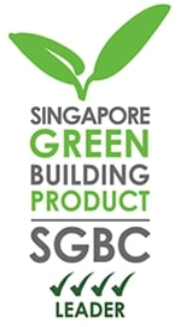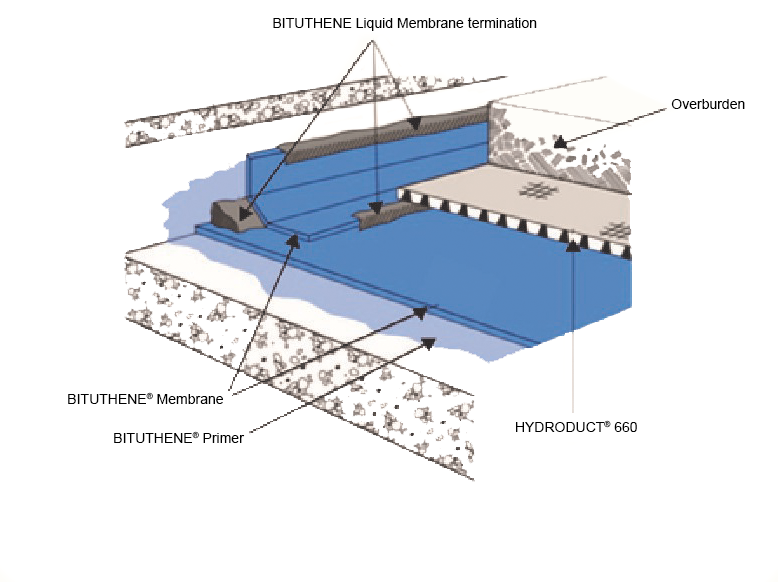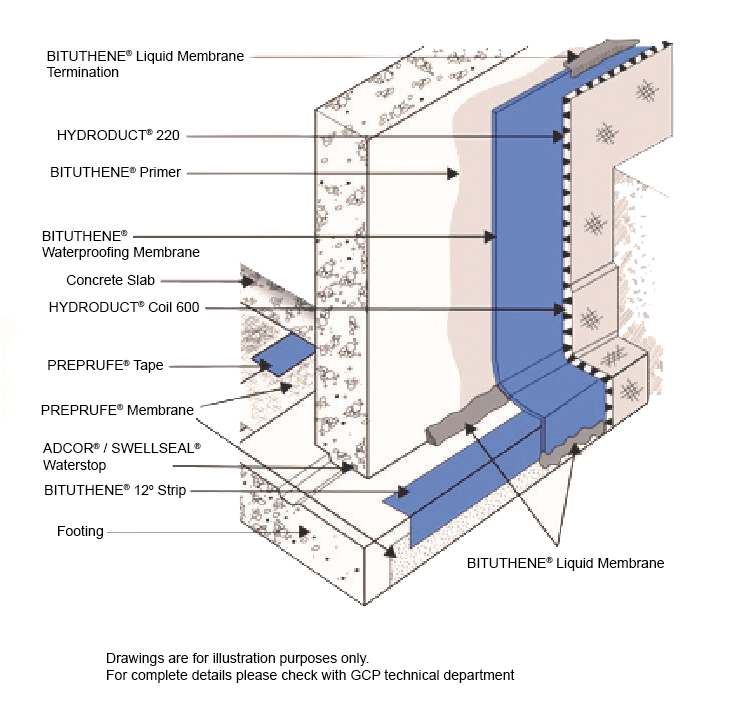BITUTHENE® 3000/3000HC & 3000 LT membranes
Product Description
BITUTHENE® 3000/3000HC & BITUTHENE 3000 LT membranes are self-adhesive, rubberized asphalt/polyethylene waterproofing membranes for on grade plaza and parking decks and below grade basements, tunnels and other subterranean applications.
GCP Applied Technologies’ (“GCP”) BITUTHENE 3000/3000HC & BITUTHENE 3000 LT Membranes combine a robust, flexible, high performance, cross laminated, HDPE carrier film with a tacky, self-adhesive rubberized asphalt compound specifically designed to adhere to cured concrete surfaces.
Product Advantages
- GCP (Singapore) Pte Ltd is certified to ISO 9001 and ISO 14001
- Specifically designed as a barrier to water, moisture and gas by physically isolating the structure from the surrounding substrate
- Resistant to hydrostatic head resistance
- Cross laminated film is dimensionally stable with, high tear strength, puncture and impact resistance
- Cold applied - No flame hazard; self-adhesive overlaps designed to provide membrane continuity
- Chemically resistant to most soil conditions, membrane is designed to provide effective external protection against aggressive soils and groundwater
- Flexible – Elongation in excess of 300% helps accommodate minor settlement and shrinkage movement
- Tanking security — combined flexible membrane and GCP waterstop system available for security
- Controlled thickness – Factory-made sheet allows for constant, non-variable site application
- Wide application window -
BITUTHENE LT Membrane when surface and ambient temperatures are between -4 °C and 16 °C
BITUTHENE 3000 Membrane for use when surface and ambient temperatures are between 5°C and 35°C
BITUTHENE 3000 HC Membrane when surface and ambient temperatures are between 20°C and 55°C
Sample Applications
- Basements below grade
- Sub-structures
- Flat decks: Plaza decks / Roof gardens / Terraces
- Roof assemblies
- Elevated or grade level podiums
- Tunnels
System Components
Membranes
BITUTHENE 3000/3000HC/3000LT
Ancillary Components
- BITUTHENE Primer N, B1, B2 solvent-based primer to increase adhesion of BITUTHENE 3000 Membranes to concrete surfaces
- BITUTHENE Liquid Membrane – Two component, elastomeric, liquid applied detailing compound
- BITUTHENE Mastic – Rubberized asphalt-based mastic
- HYDRODUCT® Drainage Sheet - High impact and creep resistant geo-composite and protection layer
The most current Data Sheets for most system components are available at gcpat.com. For more information on any system or ancillary component contact your local GCP technical service advisor.
Limitations of Use
- Approved uses only include those uses specifically detailed in this product data sheet and other current product data sheets that can be found at gcpat.com.
- BITUTHENE Membranes are not intended for any other use. Contact GCP Technical Services where any other use is anticipated or intended.
- BITUTHENE Membranes are designed where in-service temperatures will not exceed 54°C.
- Do not use BITUTHENE Mastic to terminate BITUTHENE Membranes to PREPRUFE pre-applied waterproofing membrane systems. Terminations to PREPRUFE membranes should only be done with BITUTHENE Liquid Membrane.
- Do not apply BITUTHENE Membranes over insulation or lightweight insulating concrete.
Safety and Handling Information
Users must read and understand the product label and safety data sheet (SDS) for each system component. All users should acquaint themselves with this information prior to working with the products and follow the precautionary statements. SDSs can be obtained by contacting your local GCP representative or office, and in some cases from our web site at gcpat.com.
Storage
- Observe one-year shelf life and use on a first in, first out basis.
- Store in dry conditions between 5°C and 32°C.
- Store off ground, under tarps or otherwise protected from rain and ground moisture.
- See Technical Letter #TL-0030(AP) Shelf Life/Storage and Handling of GCP Waterproofing.
Installation
Temperature
- Apply BITUTHENE 3000 Membrane only in dry weather and when air and surface temperatures and at 5°C to 35°C
- Apply BITUTHENE 3000 HC Membrane at 20°C to 55°C
- Apply BITUTHENE LT Membrane at -4°C to 16°C
- Apply Primer N, B1, B2 above -4°C (See separate product information sheet.)
Surface Preparation
Surfaces must be structurally sound and free of voids, spalled areas, loose aggregate and sharp protrusions. Remove contaminants such as grease, oil and wax from exposed surfaces. Remove dust, dirt, loose stone and debris. Concrete must be properly cured (minimum 7-days for normal structural concrete and 14-days for lightweight structural concrete). For horizontal applications, double the above cure times of concrete if placed over non-vented decks. Certain conditions may require longer dry times, such as unusually wet weather or late removal of forms.
On vertical applications if time is critical Primer N, B1, B2 may be used to allow priming and installation of membrane on damp surfaces or green concrete. Priming may begin in this case as soon as the concrete will maintain structural integrity. Use form release agents which will not transfer to the concrete. Remove forms as soon as possible from below horizontal slabs to prevent entrapment of excess moisture. Excess moisture may lead to blistering of the membrane. Cure concrete with clear, resin-based curing compounds which do not contain oil, wax or pigment. See Technical Letter TL-0005 Curing Compounds and Form Release Agents. Except with Primer N, B1, B2 allow concrete to thoroughly dry following rain. Do not apply any products to frozen concrete.
Repair defects such as spalled or poorly consolidated areas. Remove sharp protrusions and form match lines. For rough or uneven deck surfaces use BITUTHENE Deck Prep as a repair and leveling agent. See Above Grade Waterproofing BITUTHENE Deck Prep product information sheet for details. On masonry surfaces, apply a parge coat to rough concrete block and brick walls or trowel cut mortar joints flush to the face of the concrete blocks.
Priming
- Apply Primer N by roller at a coverage rate of 5-8m2/L, B1 at a coverage rate of 6-10 m2/L & B2 at 8-10m2/L. Allow to dry up to two hours, or until tack-free
- Do not apply any primer directly onto any BITUTHENE Membranes
Application on Horizontal Surfaces
(Note: PREPRUFE® pre-applied membranes are recommended for below slab or for any application where the membrane is applied before concreting. See PREPRUFE Waterproofing Membrane product information sheets.)
All horizontal surfaces should be sloped to drain at least 11 mm/m. When a minimum slope of 11 mm/m cannot be achieved, 2 layers of BITUTHENE Membrane.
Apply membrane from the low point to the high point so that laps shed water. Overlap all seams at least 50 mm. Stagger all end laps. Roll the entire membrane firmly and completely as soon as possible. Use a linoleum roller or standard water-filled garden roller less than 760 mm wide, weighing a minimum of 34 kg when filled. Cover the face of the roller with a resilient material such as a 13 mm plastic foam or two wraps of indoor-outdoor carpet to allow the membrane to fully contact the primed substrate. Seal all T-joints and membrane terminations with BITUTHENE Liquid Membrane by the end of the day.
Application on Vertical Surfaces
Apply membrane in lengths up to 2.5 m. Overlap all seams at least 50 mm. On higher walls apply membrane in two or more sections with the upper overlapping the lower by at least 50 mm. Roll all membrane with a hand roller.
Terminate the membrane at grade level. Press the membrane firmly to the wall with the butt end of a hardwood tool such as a hammer handle or secure into a reglet. Failure to use heavy pressure at terminations can result in a poor seal. All top of wall terminations must be sealed with BITUTHENE Liquid Membrane BITUTHENE Mastic. A termination bar may be used to ensure a tight seal. At the end of each working day, if the wall has been only partially covered, apply a maximum 6mm bead of BITUTHENE Mastic tooled thin or BITUTHENE Liquid Membrane along the exposed edges of the membrane at its temporary terminations to prevent vertical drainage of precipitation undermining the membrane adhesion. Terminate the membrane at the base of the wall if the bottom of the interior floor slab is at least 150 mm above the footing.
Otherwise, use appropriate inside corner detail where the wall and footing meet. A 3 mm x 25 mm aluminum termination bar aligned with the top of the membrane is recommended for terminations on CMU, in earth covered decks, and in earth bermed applications where soil cannot be fully compacted. See Technical Letter TL-0026(AP) BITUTHENE Membrane Terminations for additional information.
For technical assistance with detailing and problem solving please call your local GCP representative.
Membrane Repairs
Patch tears and inadequately lapped seams with the same membrane as used on the surrounding surface. Clean the in place membrane with a damp cloth and completely dry. Slit fishmouths and repair with a patch extending 50 mm in all directions from the slit and seal edges of the patch with BITUTHENE Liquid Membrane. Inspect the membrane thoroughly before covering and make all repairs prior to testing, covering or backfilling.
Flood Testing (Horizontal Surfaces Only)
- Flood test all horizontal applications with a minimum 50 mm head of water for 24-hours. Mark any leaks and repair when the membrane is dry. Before flood testing, be sure the structure will withstand the dead load of the water. For sloped decks, it may be necessary to segment the flood test to avoid deep water near drains.
- Conduct the flood test 24-hours after completing the application of BITUTHENE waterproofing system. Immediately after flood test is completed, and all necessary repairs made, install drainage composite to protect the BITUTHENE membrane from traffic and other trades.
- As an alternate to flood testing, appropriate electronic leak detection may be used to check the integrity of the system.
Drainage
HYDRODUCT drainage composites are recommended for both active drainage and protection of the membrane. See HYDRODUCT product data sheet at gcpat.com.
Insulation
Always apply BITUTHENE Membrane directly to primed or conditioned structural substrates. Insulation, if used, must be applied over the membrane. Do not apply BITUTHENE membranes over insulation or lightweight insulating concrete.
Protection of Membrane
Protect BITUTHENE Membranes to avoid damage from other trades, construction materials or backfill. At temperatures above 25°C to avoid potential formation of blisters place protection immediately.
- On vertical applications, use HYDRODUCT 220 drainage composite. Adhere HYDRODUCT 220 drainage composite to membrane with PREPRUFE Detail Tape. Alternative methods of protection are to use 25 mm extruded polystyrene or 6 mm asphaltic hardboard. Such alternatives, however, do not provide positive drainage to the system. Adhere polystyrene protection board with PREPRUFE detail tape. See Technical Letter TL-0027, Protection Courses Used with GCP Waterproofing Systems for additional information.
- HYDRODUCT 220 drainage composite is for vertical use only.
- On horizontal applications, use HYDRODUCT 660 drainage composite. Alternate methods of protection are to use 25mm extruded polystyrene or 6 mm asphaltic hardboard. Such alternatives, however, do not provide positive drainage to the system.
Placing Steel
On horizontal applications when placing steel over properly protected membrane, use concrete bar supports (dobies) or chairs with plastic tips or rolled feet to prevent damage from sharp edges. Use special care when using wire mesh, especially if the mesh is curled.
Backfill
Place backfill as soon as possible. (See Protection of Membrane section above) Use care during backfill operation to avoid damage to the waterproofing system. Follow generally accepted practices for backfilling and compaction. Backfill should be added and compacted in 150 mm to 300 mm lifts.
Physical Properties:
| PROPERTY | TYPICAL VALUE | TEST METHOD |
|---|---|---|
| Colour | Dark gray-black | |
| Roll Dimensions3 | 1m x 20m | |
| Roll Weight | Bit 3000/Bit 3000HC: 39 kg Bit 3000LT: 35.5 kg | |
| Thickness | 1.5 mm(nominal) | ASTM D3767 - method A |
| Flexibility, 180° bend over 25 mm mandrel at -32°C, and -15° for HC version | Unaffected | ASTM D1970 |
| Tensile strength, membrane | 4N/mm | minimum ASTM D4121 |
| Tensile strength, film | 34.5 MPa minimum | ASTM D8821 |
| Elongation, ultimate failure of rubberized asphalt | 300% minimum | ASTM D4121 |
| Crack cycling at -32°C, 100 cycles, and 23° for HC version | Unaffected | ASTM C836 |
| Lap Adhesion @ 23°C | 683N/m | ASTM D1876 |
| Peel strength | 1576 N/m | ASTM D9034 |
| Tear Resistance | 23N/mm | ASTM D624 |
| Puncture resistance, membrane | >222 N | ASTM E154 |
| Resistance to hydrostatic head | 70m of water | ASTM D5385 |
| Permeance | 5.7ng/pa/s/m2 | ASTM E96, section 12 - water method |
| Water absorption | <0.1% | ASTM D570 |
1. The test is run at a rate of 2 in. (50 mm) per minute.
2. The test is conducted at 4 in. (102 mm) per min.
3. Individual roll length may vary +/- 1%
4. Peel strength on primed concrete
gcpat.id | For technical information: asia.enq@gcpat.com
We hope the information here will be helpful. It is based on data and knowledge considered to be true and accurate, and is offered for consideration, investigation and verification by the user, but we do not warrant the results to be obtained. Please read all statements, recommendations, and suggestions in conjunction with our conditions of sale, which apply to all goods supplied by us. No statement, recommendation, or suggestion is intended for any use that would infringe any patent, copyright, or other third party right.
ADCOR, BITUTHENE, HYDRODUCT, PREPRUFE and SWELLSEAL are trademarks, which may be registered in the United States and/or other countries, of GCP Applied Technologies, Inc. This trademark list has been compiled using available published information as of the publication date and may not accurately reflect current trademark ownership or status.
© Copyright 2024 GCP Applied Technologies, Inc. All rights reserved.
GCP Applied Technologies Inc., 2325 Lakeview Parkway, Alpharetta, GA 30009, USA
PT GCP Applied Technologies Indonesia, Cikarang Industrial Estate Kav C-32, Cikarang, Bekasi 17530
This document is only current as of the last updated date stated below and is valid only for use in Indonesia. It is important that you always refer to the currently available information at the URL below to provide the most current product information at the time of use. Additional literature such as Contractor Manuals, Technical Bulletins, Detail Drawings and detailing recommendations and other relevant documents are also available on www.gcpat.id. Information found on other websites must not be relied upon, as they may not be up-to-date or applicable to the conditions in your location and we do not accept any responsibility for their content. If there are any conflicts or if you need more information, please contact GCP Customer Service.
Last Updated: 2025-10-07
https://gcpat.id/en-gb/solutions/products/bituthene-post-applied-waterproofing/bituthene-30003000hc-3000-lt-membranes


